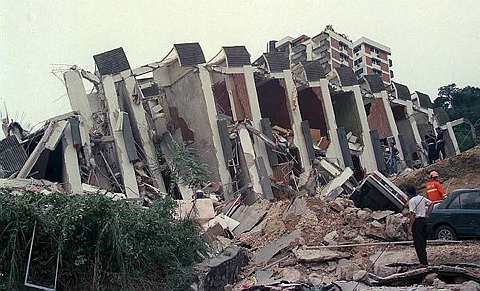
Days after the collapse of the Jaya Supermarket and the Sultan Mizan Zainal Abidin Stadium in Terengganu, the lay-blame game begins. In the case of the Jaya Supermarket, the Petaling Jaya City Council hastily declared that the architect in charge of the demolition is solely responsible under the local by-laws. Similarly, in the case of the Terengganu Stadium, fingers were quickly pointed at the PWD, the architects and the contractor. And all these happened even before any probe or a commission of inquiry was established to investigate the cause of the collapse. This only shows the mentality of the authorities in understanding issues on construction liability.
It is always a complex issue when a building collapses. It is difficult to ascertain liability. First of all, we have to find out the cause of the collapse. That itself is a near-impossible task. For example, if a house is found to have cracks on its wall, then the owner should appoint consultants or experts to inspect the cracks. The consultants or experts may produce a report that the house owner may rely on to decide on the next course of action. But if the house collapses before an inspection is undertaken, then it will no longer be possible to check on anything as the whole structure has fallen to debris. There is no more evidence to rely or inspect upon. The cause of the collapse will only be a guessing game.
In the case of the Highland Tower collapse in 11 December 1993, the owners of Block 2 and 3 (the unaffected units) sued for damages. The court had to ascertain the cause of the collapse. To help the court decide, two top personalities in the field of geo-technological engineering in the world were asked to give their views. Both came up with conflicting reports. In the end, the court had to choose between one to another. Even the top experts cannot agree as to the cause of the landslide. Based on the conflicting theories, it is safe to say that the cause of the Highland Tower landslide will never be accurately known.
There is also another problem arising in this area. In cases of latent defects, the damage takes place underground in the foundations or inside the walls so at the time of its occurrence it is unknown and undiscoverable. The damage caused by the defective work may not become apparent even until the completion of the project and its untimely collapse.
In the event we are able to conclude – against the odds – on the exact cause of a collapse, we now have to connect the cause of the collapse to the responsible party. This is not going to be easy. There are many parties involved in the construction of a building. There is the owner – the one who commissions for the construction of the building. The owner will appoint an architect to design the building.
Once the design has been drawn out, other professionals such as engineers and quantity surveyors will be appointed to conduct engineering and surveying work. It is also common for project managers to be hired to oversee the project. All the necessary building approvals in respect of the construction will be made to the authorities. Tenders will then be given to appoint builders or contractors to construct the building. In big projects, a main contractor will be appointed. The main contractor will then appoint sub-contractors – some of them specialist in their own field – to do part of the job. Lastly, there are suppliers who supply the building materials to the contractors.
With so many parties involved, we have to carefully link the cause of a building collapse to the correct responsible part. For example, if the cause were due to negligent design, then the architect would be liable. Similarly, the architect can also be liable for negligent certification, negligent supervision and negligent inspection. A project manager can also be liable for supervision and inspection if they are so appointed for the task and fail to act reasonably. If the cause is due to negligent construction or negligent workmanship, then the main-contractor or the sub-contractor may be liable. If it is negligent approval, then the authorities may be liable. Suppliers may be liable if inferior materials are being supplied.
However, liability of a party is never clear-cut. If a builder is expressly instructed by the owner to use inferior materials, and the builder in such a case have expressly advice against the use of such materials, can the builder then expressly disclaim liability and responsibility by contract to the owner? Similarly, whether a particular problem was caused by inadequate supervision would be influenced directly by the amount of resources the architect was required to deploy on supervision. Unlike design, supervision costs are entirely time and labour related. It is largely for the client and the consultant to negotiate and decide how much resource should be applied to secure supervisory functions beyond the minimum required.
Construction liability is additionally made more difficult by the defence of Act of God. This is a defence readily employed in cases of landslides. Act of God has been described where an escape occurred through natural causes and without human intervention in circumstances that no human foresight can provide against and of which human prudence is not bound to recognize. Lightings, earthquakes, cloudburst and tornadoes may amount to an Act of God.
Once we are able to ascertain the cause of a collapse and correctly linking it to the responsible party or parties, we then have to consider the type of liabilities attracting the careless act. Liability can be three types: – contract, tort and statute. A construction project is managed by an intricate web of contracts to define their relative rights and responsibilities. An owner may have signed a contract with the main-contractor but not with the sub-contractors or suppliers. The architect or engineer has no contract with the contractor. Where there is no contract, parties may then rely on the law of negligence to impose tort duties to cut across contractual lines. A party may also be additionally liable under a statute, such as the Occupational Safety and Health Act 1994.
With such a complex area to grapple and understand, the government should take other pro-active steps to avoid future disasters. The passing of the Construction Industry Development Board Act 1994 and the Occupational Safety and Health Act 1994 is a good move. But it is not good enough. Perhaps we can take a cue from neighbouring Singapore. In 1987, the Hotel New World collapsed. It is the first ever collapse of a building in Singapore. Following the recommendations of the Report of the Inquiry and the Report of the Select Committee on the Building Control Bill (Bill No. 3/88), the Building Control Act 1989 was enacted.
The Singapore Building Control Act 1989 introduced several new measures to regulate the construction industry. In regulating the design and supervision of a construction building, a developer must appoint an Accredited Checker, whose main duties are to evaluate, analyze and review the structural design in the plans of any building works and perform such original calculations with a view to determining the adequacy of the key structural elements of the building to be erected or affected by the building works carried out in accordance with those plans. The Accredited Checker must be independent in that he must have no professional or financial interest in the building works.
Apart there from, the Building Control Act also regulates workmanship and materials by empowering the Minister to make regulations on the suitability and use of materials and components. Any building regulations may adopt any code, standard, rule, specification or provision which is recommended, issued or adopted by the Productivity and Standards Board of Singapore or the British Standards Institution. In the later Building and Construction Authority Act passed in 1999, the Singapore’s Building and Construction Authority has been empowered to prescribe standards for the construction industry in relation to design, processes, construction techniques, products and materials.
Singapore’s Building Control Act 1990 also provides for periodical inspection of buildings by an independent structural engineer. The appointed structural engineer must carry out the inspection, prepare, sign and deliver a copy of the report to the Building Authority. If the report contains any measure or other recommendations to be carried out to ensure the structural stability or integrity of the building, the owner must carry out the same within the period as may be specified by the Building Authority. The Building Authority may, if it appears that a building is in such a condition as to be likely to be dangerous, order the owner to carry out or cause to be carried out such inspection of the building as he may specify and/or to execute such building works as may be necessary to obviate the danger and/or to demolish the building or any part thereof. Alternatively, the Building Authority may order the closure of the building.
In summary, we are able to see and appreciate that construction liability is a complex issue. Finding a cause of a collapse of a building is never easy. For most of the time it will be a guessing game or a process of elimination. With so many parties involved in a constructions project, it will also be difficult to ascertain who is liable for what. With so many uncertainties and issues at hand, it is best for the Government to take pro-active steps to better regulate the construction industry. The developments in Singapore would be a good starting point for us to compare and emulate. The current existing laws that we have may not be adequate and may need to be improved on.




